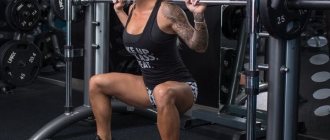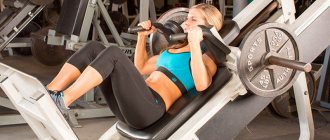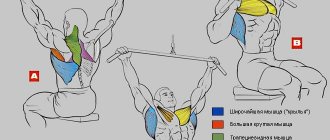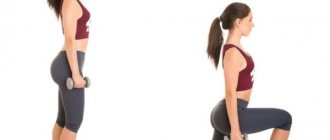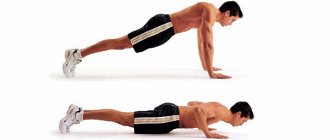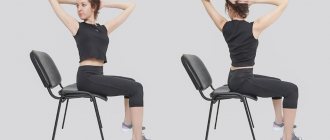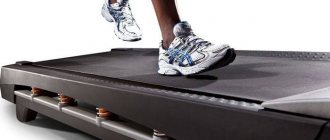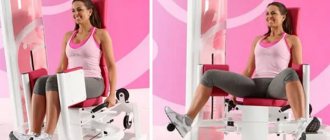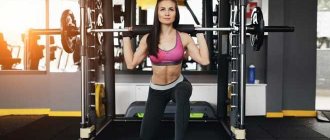The material was prepared by the site team with the support of our experts: athletes, coaches and nutrition specialists. Our team >>
- Reading time: 5 min.
- Which exercise machine should I use?
- Seated press machine
- Hummer Seated Press
- Seated press and Smith machine
- Seated Angle Press
- Seated Vertical Press
- How to best combine exercises
We recommend reading: Exercises for arm muscles for women
The bench press is a universal exercise that can be used to pump up the upper and middle part of the chest, shoulders, and triceps. On the one hand, this is an imitation of a bench press, on the other hand, a barbell press at different angles and even a seated dumbbell press. And all this is possible thanks to the variety of seated press machines (from the Hammer to the Smith).
Exercises
All chest muscles can be roughly divided into three parts - upper, middle and lower. Each part is better stimulated depending on the change in angle at which you perform the exercise.
- For the upper part, exercises performed on a bench at an upward angle of 30-45% are best suited.
- For the middle part, exercises performed on a flat bench are best.
- For the lower part, exercises performed on a bench at a downward angle of 30-45% are best suited.
All chest exercises must be performed with perfect form because poor form can become a habit that will lead to lack of progress or worse, injury in the future. The following are exercises you can do to train your chest muscles, and a step-by-step guide will help you achieve perfect technique.
Seated press machine
Don’t forget to do a good warm-up and warm up your joints. Next, hang a small weight on the machine (20–30 kg is enough for men, 1–5 kg for girls – depending on physical fitness). This will be a warm-up approach.
- If the simulator has the option of adjusting the seat and back, adjust everything to suit you. You need to sit on the simulator chair, pressing your body tightly against the back. If your lower back is far from it, this is the wrong position.
- Sit down and bend your lower back forward, straighten your shoulders, take a deep breath and exhale. Get ready to breathe correctly: exhale during the push, inhale when returning to the starting point.
- Grasp the handles so that you are comfortable. If the machine has an auxiliary pedal for lifting weights, press it with your foot - this will help raise the handles to the starting position. If this is not provided, lift the weight with your arms.
- Push the handles with the strength of your pecs, shoulders and triceps, exhaling. Now lower the weight back down while inhaling. You can’t hold your breath, don’t forget about it!
- Repeat the movement 10–15 times without haste, thoughtfully. This was a warm-up approach.
Now set the desired weights and do 8-12 repetitions in 3-4 sets, or in other combinations, depending on your program.
Seated bench press
There are various options for simulators for performing this exercise. However, absolutely all of them are designed to work the pectoral muscles. The trajectory of movement that the machine sets allows you to focus on the target muscle group while minimizing the involvement of the shoulder muscles.
The horizontal bench press allows you to work the muscles from different angles compared to the standard vertical bench press. Some exercise machines allow you to adjust the seat height, which allows you to shift the emphasis to the upper or lower part.
Technique:
- Get on the machine and choose the weight that's right for you. Hold the handles of the machine with your palms facing down and raise your elbows so that your upper arms are parallel to the floor. Push the handles forward and extend your arms. This is the starting position.
- As you inhale, pull the handles of the exercise machine towards you. As you exhale, push them away from you. Hold the squeeze for a second before returning to the starting position. Try to keep your shoulders and back on the bench.
- Do the recommended number of repetitions. Slowly return the handles to place when you finish your set.
Do 3 sets of 10-12 reps, resting 45 seconds between sets.
Which exercise machine should I use?
Let us explain that the choice of a simulator (or let us agree that we will henceforth talk about the angles of the force vector relative to the floor) depends on what muscles you want to pump.
We advise you to read: Bend your arms in the lower block
In this article we will take an overview of the most important techniques in various simulators:
- To pump up your chest, you need to choose a machine that simulates a bench press. Usually this is a device with a seat and a backrest at right angles to it. The handles that will need to be pushed away from you (press) are located at the level of the bottom of the chest. The exercise is more similar to a reverse grip press, although the palms are in a straight position.
- To work the shoulders you will need a hammer and a Smith machine. In a Hummer you can pump up the front deltoids. This is a good option after the classic bench press and incline press.
- In Smith, you can do presses at different angles, as well as a seated barbell press (when you press it vertically up, bringing it behind your head or onto your chest).
Thus, the choice of a simulator will directly depend on what you want to train today. And, of course, it depends on what kind of exercise equipment is available in the gym you come to.
Seated Angle Press
This exercise is almost identical to the classic bench press in a seated machine. However, the machine in which it is performed has an incline bench, which allows you to better focus on the upper part of the pectoral muscles.
Technique:
- Start by adjusting the seat of the bench so that the arms of the machine are in line with your upper chest. Also set the appropriate load. Sit on a bench and grab your hands. This will be your starting position.
- As you inhale, begin to slowly push the handles of the machine forward until your arms are fully extended. You should feel a stretch in your pectoral muscles. Hold this position for a couple of seconds and then slowly return to the starting position.
- Do the recommended number of repetitions.
Seated bench presses on the pectoral muscles will allow you to effectively work out your muscles. Do 3 sets of 10-12 reps, resting 45 seconds between sets.
Work of muscles and joints
The angle press concentrates the load on the upper pectoral muscles, but part of the load falls on the biceps, triceps and anterior deltoids of the shoulder girdle. Due to the position of the body, it is possible to reduce the load on the lower bundle of pectoral muscles and transfer it to the top. Therefore, the position of the body must be correct.
At the bottom of the movement, the load falls mainly on the elbow joint. This is why the barbell must be lowered to the chest, and not stopped suspended. At the top, on the contrary, the shoulder girdle receives the main load, which necessitates the need to use the help of a partner when removing the bar from the rack.
Smith machine chest press
This exercise is perfect for beginner athletes who are just learning to feel their muscles. The bench press with free weights allows you to move through a greater range of motion, but it is not as safe. The Smith machine has hooks that you can use to secure the barbell if you feel like you can't complete a rep.
If you are new to this exercise, ask a trainer or friend to guide you. If this is not possible, then do not lift heavy weights to avoid injury.
Technique:
- Place a flat bench under the machine. Then set the barbell to such a height that you can reach it with straight arms from a lying position. Once you have established a weight that suits you, lie down on a flat bench. Place your hands on the barbell at a shoulder-width distance apart, using a pronated grip. Remove the bar from its safety catches and hold it straight above you with your arms extended. This will be your starting position.
- As you inhale, gradually lower the barbell until it rests on your mid-chest. As you exhale, after a short pause, return the barbell back to its original position. Hold at the top for a second, and then begin to slowly lower the barbell down again.
- Do the recommended number of repetitions. When you're done, lock the barbell into the machine.
Do 3 sets of 10-12 reps, resting 45 seconds between sets.
Advantages and disadvantages of the chest press
Advantages
- Isolated work of the pectorals with less involvement of the stabilizer muscles.
- The ability to work on each side separately. This will lead to a reduction in developmental imbalances.
- It is safe to perform bench presses on the machine. Even if you can't press the weight for one more rep, it still won't crush you. How this can happen when working with a barbell. Therefore, it becomes possible to work to failure without the help of a belayer.
- The load on the shoulder muscles, especially on the anterior bundles, is much less. Than when working with free weights (barbell, dumbbells).
- Makes it possible to finish off the pectoral muscles at the end of the workout (pumping). That is, the muscles are filled with blood and oxygen. Which contributes to better recovery after strength training.
- You can work with quite a lot of weight. Of course, the main thing is not to overdo it.
- Performing bench presses in the simulator occurs at a very large amplitude. Therefore, we can properly stretch the muscles at the lowest point.
- Ability to work with heavy weights in the eccentric phase (lowering the weight). This will trigger new stress and hormone production. Giving impetus to muscle growth.
As you can see, bench press in the simulator will help you get out of stagnation. This is especially true for professional athletes.
Flaws
- The bench press cannot replace basic exercises in terms of effectiveness.
- For some athletes, the vector set by the simulator may not be anatomically convenient. Consequently, they will not be able to develop the full potential of the pectoral muscles. Fortunately, such cases do not occur so often.
Basic exercises will always be most effective if our goal is to build muscle mass. But if we are talking about detailing the muscles and giving them shape. This is where isolated exercises come into play. Which includes the bench press in the simulator. Therefore, this drawback will be relevant only if we want to increase mass with the help of this exercise.
Hand curls in the simulator
To train your chest, it is important to combine two types of movements: compression and deep stretching. The hand pinch machine helps you do both of these. The butterfly exercise (peck-deck) is an isolating exercise that allows you to strongly compress the chest muscles and then stretch them in a negative phase.
Technique:
- Set the weight that suits you. Your shoulders should be parallel to the floor, so adjust the machine accordingly. Sit with your back resting on the exercise pad. Take your pens. This will be your starting position.
- As you exhale, slowly begin to bring your arms together, squeezing your chest muscles. Hold the contraction for a second at the peak point. As you inhale, return under control to the starting position until your pectoral muscles are fully stretched.
- Do the recommended number of repetitions.
A good training option would be to combine hand presses in a machine with push-ups. Once you complete 20 reps, move on to 20 push-ups. Perform 3 supersets in this manner, taking a 60-second break between exercises.
Incline press for girls
Does the female gender need it?
I think yes and no.
Will explain. The pectoral muscles in women are very small by themselves.
Female Breasts = Some muscle + Breast + Fat.
There’s nothing special to pump there, so I don’t see any point in doing a separate chest workout! At most, I would advise doing dumbbell presses on an incline bench, because... This is the most effective exercise for chest development. And most girls don’t need more.
Most likely, there will not be enough recovery abilities.
Or you can do the incline press upside down in Smith, as I described above.
Don’t forget that girls have very few muscles in the upper body compared to the lower part, so send to the forest those who are trying to train you according to the men’s program, and even according to a deep split (each muscle group separately).
Mistakes in training the pectoral muscles
The two biggest mistakes most people make in their training are:
- Focusing on the wrong exercises. Many people pay excessive attention to machines and isolation exercises, which have a secondary role in creating impressive muscle mass in the chest muscles.
- Lots of repetitions. Repeated training will only tone the muscles, but not build them.
The more you perform compound movements with heavier weights (80-85% of your maximum and above), the better your results will be.
Anatomy
The angled press pumps up the genetically inferior upper bundle of pectoral muscles. At the same time, since the exercise is basic, an array of other muscle groups is also pumped. The anterior bundle of the deltoid muscle is very heavily loaded, but the shoulders are not in the best position, and therefore you should not overload them.
The joints in this exercise are at a disadvantage when the athlete removes the bar from the rack, so you definitely need the help of a partner who will give you this bar, otherwise you will get injured. The elbows are well loaded at the bottom point when the barbell is lying on the chest, but at the top the elbows can be kept straight, which will help avoid excessive wear and tear on them.
Other exercises
Execution technique
Initial position
- A beginner can start the exercise with the weight of the machine itself, without weights. The person who continues already knows how much weight he needs for warming up and adds additional weights. First we assemble the simulator;
- Then the height of the bench is adjusted. Typically, this type of exercise machine has an adjustable seat, and you need to make sure that in the initial position the thigh is parallel to the floor;
- You should sit in the simulator, bring your shoulder blades together and lower them towards your pelvis. But you shouldn’t “forcibly” press your lower back against the back of the exercise machine. The position of the shoulder blades should be natural for all pressing movements that exist.
Movement
- An athlete performs a chest press. By contracting the pectoral muscles, he pushes the handles of the machine forward with his hands;
- Then follows the reverse movement - bending the elbow joints and lowering the weight onto the chest;
- After this, the required number of repetitions is performed and the athlete completes the exercise;
- The working weight may increase from approach to approach if this is provided for in the plan.
It's a HUMMER PRESS, baby!
Attention
- This is not a competition press where you have to stick your elbows in to get a pass. The pectoral muscles work great even if you don’t perform a lockout;
- The Hammer Press involves gathering the shoulder blades and fixing them against the spine. You should not take a starting position in which your back and lower back are tightly pressed against the back of the exercise machine. Not all people can achieve a forward pressing movement with a relaxed back and slightly rounded shoulders forward. On the contrary, they will experience pain if they begin to bench with this particular technique;
- The Hummer press does not allow for significant grip width adjustment. The only way to adjust is to adjust the height of the machine. The grip width will be determined by the length of the handles. For those who have narrow shoulders and back, it is recommended to take it as narrow as possible and as comfortable for the shoulders as possible;
- There is no need to lift your back from the backrest, nor do you need to move your shoulders forward or nod your head. These “auxiliary movements” interfere with the technical execution of the exercise and prevent activating the chest muscles;
- The arms should roughly project to the middle of the chest. If they are higher, then injury to the tendons of the shoulder is possible, because the position of the shoulder joint becomes anatomically incorrect;
- Avoid arching your wrists; if they are arched, the entire weight of the machine will be on them, not just the chest muscles. This is a very unfavorable position due to the fact that it contributes to injury;
- Gradually approach the working weights. Do not use maximum weights, especially if you have been working in the simulator recently and have also recently entered the gym. Avoid a machine that is too overloaded and requires you to press the weights with your hands one at a time. Work in the Hummer, although considered by many bodybuilders to be a strength training, is not actually a “platform for setting records.” Be adequate in choosing working scales.
